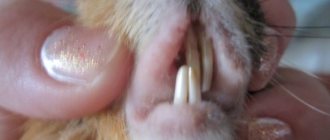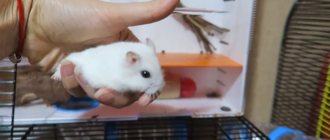- home
- General information
15.04.2018
Noise, fuss, and the patter of little paws are an integral part of life with a hamster. Babies make these sounds at night, during periods of activity. The nocturnal activity of hamsters brings discomfort to the owner of the furry creatures. Animals disturb sleep and frighten owners. Many owners are perplexed: why does the hamster chew on the cage when there are enough toys and “tools” for sharpening its teeth in the house. Let's look at this issue further.
Causes
Since it is impossible to simply ask your pet about the reasons for such behavior, all that remains is to make assumptions based on the needs of the animal and its natural instincts. Most often, the desire to try a cage on a tooth is caused by one of the following:
- Physiological need for grinding teeth . It is not without reason that hamsters belong to the order of rodents, and that is why their attention is attracted by the metal rods that surround the pet most of its life. Of course, with great pleasure he would gnaw on dry branches of fruit trees or plant roots, as happens in nature, but in their absence in the cage, there is nothing left to do but grab the metal wire.
- The pet is bored . Another fairly common reason is the inability to carry out normal life activities in the limited space of a cell and, as a result, the search for new activities. In their natural habitat, hamsters are almost constantly on the move: they dig holes, look for food, store supplies for hungry times and, of course, run away and hide from predators. In an apartment, the opportunities to occupy yourself are not so wide, so you have to look for an affordable activity.
- He's hungry . It is quite possible that the animal in this way simply draws your attention to depleted or spoiled supplies or a complete lack of food.
- Violation of the regime . Nature has decreed that the main activity of hamsters occurs in the dark. Accordingly, they spend most of the daylight hours gaining strength by sleeping thoroughly. A person usually does not pay attention to such trifles and actively makes noise in his free time, thereby preventing the fluffy ball from living in its established rhythm. Due to the disruption of the usual schedule, the animal may become irritable, restless and noisy, which is why at night it may well take revenge on you with a loud crunch of bars.
- I didn't like the cage . We should not exclude the fact that the hamster has simply grown up, he no longer has enough space in the cage, and now he is trying with all his might to escape.
Ways to solve the problem
In addition to the inconvenience for owners caused by loud grinding, the danger of constantly gnawing metal rods is that the animal can:
- damage gums and severely break teeth;
- poisoned by the paint that covers the cell;
- get stuck;
- get hurt by escaping from your home.
To avoid such unpleasant situations, check out the common ways to pacify your pet, redirect its irrepressible energy in another direction and prevent damage to the hamster’s abode.
Is this harmful for the pet?
In addition to the fact that a furry homebody will constantly wake you and your family with its night fussing and loud grinding, which is quite unpleasant, especially if it happens regularly, there is also a danger in such actions for the animal itself.
Firstly, the material of the cage is strong enough to not only wear down, but also break teeth - after all, in nature, a rodent usually uses pieces of wood or crunchy food, much softer than metal rods.
Secondly, the rods are often covered with paint, which gradually begins to crumble and get into the stomach. And even if it does not lead to health problems, there is no benefit from such a “food additive”.
Sorry, there are no products matching your search parameters in this category.
Possible consequences of this behavior
The metal bars of your home are not a suitable material for grinding down teeth. Thus, the animal can break them and injure the oral cavity. In this case, you will have to show your pet to the veterinarian. In addition, such a grinding noise will constantly disturb the animal’s owners from sleeping at night.
Important! It should be noted that the metal bars of such a dwelling are often coated with paint, which, if it gets into the intestines of a rodent, can cause problems with its health.
How to stop a hamster from chewing its cage?
In fact, ways to counteract such behavior are quite easy to select based on the reasons themselves.
- Remember to give your pet solid food along with regular grains and cereals so that the teeth grinding needs are met naturally. Additionally, you can place small twigs or special mineral stones in the cage, sold in pet stores. They will also be a very interesting and useful activity that distracts the animal from a bad habit.
- Try to periodically, preferably even daily, walk your hamster in the apartment. This will give him the opportunity to run around and use up the accumulated energy. There are several options for the “walk”. You can monitor the pet yourself, limiting its movements, or organize a small “pen” in a safe area (where it cannot find a cozy hole). Usually, over time, animals get used to walking and, tired, they themselves tend to return to the cage, if they have access to it, since this is where their home is located with a nest for sleeping and food supplies. If for some reason it is impossible to organize a walk in this way, you can try giving the rodent a special ball for walking. It will provide freedom of movement and prevent the animal from going where it shouldn’t.
- Try to arrange the cage so that there is always something to do in it. Place ladders, small closed houses and a standard spinning wheel inside.
- If all of the above measures do not have an effect, there is only one option left - to use a repellent. It is usually created on the basis of natural ingredients that have an unpleasant smell and taste for rodents. To do this, you need to remove the animal, treat the rods, wait for them to dry, and only then return the resident to his place. Having taken up the usual task, the rodent will be very surprised by the bitterness and unpleasant taste of the twigs, after which the desire to gnaw on them should completely disappear.
Well, we hope you were able to understand why a hamster chews on its cage. Now all that remains is to choose the most effective method among the proposed options.
Nuances of weaning a hamster
Before replacing your hamster's cage, you need to pay attention to its condition and check whether it meets the following requirements:
- Has enough space to accommodate the animal.
- Equipped with tunnels, slides and a wheel.
In the behavior of dzhungariks there is a pronounced tendency to escape, so they gnaw on the bars in the area where they exit the cage. Representatives of the Syrian breed are considered to be calmer, and if they have not chewed on bars before, this behavior may be due to a lack of other activity.
If you find that your hamster has started to engage in this habit, offer him a stick or twig to replace one activity with another.
Maintain gentle persistence and be attentive to the animal's wishes.
Weaning a hamster from a bad habit
If your hamster chews the cage regularly, it may cut itself. But this is not the only reason to wean a rodent from a bad habit - characteristic sounds prevent a person from sleeping at night, because hamsters are nocturnal animals.
In theory, many people know how to wean hamsters from gnawing their cage, but in practice this is difficult to do, because the instinct to “gnaw” is genetic. The upper teeth grow throughout the animal's life because they do not have roots. In nature, hamsters eat grains and roots, although they contain few nutrients, but thanks to this diet, their teeth wear down well naturally. They also dig burrows, which also shortens their teeth.
Domestic hamsters are not bothered by the problem of finding food; caring owners set up cozy houses for them. But the rodent's instincts remain the same.
Hamster breeders know what to do if a hamster chews on the cage: try to wean the pet, direct its actions in a different direction. Do not forget to add raw vegetables, fruits, crackers and other solid foods to the food. Grinding down teeth is a necessary process, because if this does not happen, the incisors will injure the hamster’s mouth, as a result of which it may die.
Important: grinding down the incisors should occur naturally; only in extreme cases can this be done by a veterinarian.
Another danger is that the hamster can chew through the cage and escape. To prevent this from happening, buy a mineral stone and special twigs for your pet. It is inexpensive, but brings maximum benefits. Pet stores sell treats for hamsters - the fluffy one will prefer to eat dried fruits and nuts than metal rods. Give solid treats no more than once a day before bed - the dzhungarik will be busy and will not interfere with your sleep. Avid hamster breeders make their own treats.
Home living
Your pet does not have to worry about food, because you constantly fill his feeder with nutritious grains. Often, owners even overfeed their pets. “But how can that be? - you object. “After all, I fill the bowl exactly according to the instructions.” It's not even that he eats a lot. He just has nowhere to waste his energy. He imposingly strolls from the house to the feeder and crunches ready-made grains that do not need to be dug up or chewed off. But you can't argue against nature. Teeth continue to grow at the same rate as their wild counterparts. That's why the hamster chews the cage, it adjusts their length.
Special stones
Many people think that a rodent has only four teeth. In fact, there are 16 of them. 4 front canines and 6 molars on the upper and lower jaws. The enamel on the outer part of the teeth is thick, but not on the inner part. When a hamster chews something hard, due to the difference in the thickness of the enamel, the teeth wear down and become sharp. Domestic rodents need to be given solid food: grains, vegetables, fruits. But this is not enough.
At any pet store you can buy a special mineral stone for hamsters. It contains vitamins and microelements. The rodent not only sharpens its teeth, but also receives additional minerals necessary for the body. Typically these stones are white with speckles. Do not buy bright multi-colored stones; most likely, they have added dye. They almost always come with clips to easily secure them to the bars of the cage to keep them clean. A stone for hamsters can be hung in an inconvenient place, this will give the baby an incentive to additionally engage in “physical education” and improve health.
Mineral stones are available in the flavors of various vegetables, fruits and herbs. They contain up to ten microelements: potassium, zinc, cobalt, calcium. Chalk and mineral salt stones are also sold. Chalk stone saturates the rodent's body with calcium and is necessary to strengthen bones and teeth. It is not advisable to use regular “school” chalk; it is not food grade and can be dirty. Experts do not recommend giving salt and mineral salt stones; salt is harmful to small rodents. If your pet accidentally swallows too much salt, it will become poisoned and die.
If your hamster does not chew on a mineral rock, offer him a rock with a different flavor or from a different brand. If, despite the stones hanging around the “apartment”, the hamster continues to chew on the bars of the cage, try buying him a wooden toy. The pet store may also offer you special grain sticks. They are made from wheat, sunflower, oats, peas, corn, barley and nuts. The “porridge” is held together with wheat flour and corn starch with the addition of minerals and trace elements. Delicious, healthy food and at the same time an excellent sharpener.
Choosing a cell
Today, buyers have a good choice. Plastic, iron and wooden cages have their pros and cons. Most often, the strongest ones are chosen, which will not be damaged by the sharp teeth of rodents. But this is debatable. If the cage is large enough, it has a wheel and sticks for grinding teeth, then the risk to its walls is small. And if the hamster did get to the bars at night, then the sound will be much muffled and, most likely, will not wake you up. In the morning you will find traces of damage and take action. You can also tie fruit tree sticks from the inside to protect the cage from attack.
Possible dental problems in hamsters
If your pet refuses food, loses weight, and won't let you touch his cheek pouches, you should carefully examine his teeth. Such symptoms often indicate uneven growth of the incisors, as a result of which they do not grind down at the same time. As a result, the teeth grow into the cheek pouches or palate, causing pain to the hamster. The cause of uneven growth is genetic predisposition. A veterinarian will help solve the problem by trimming the incisors. The hamster does not experience discomfort during the procedure, since there are no nerve endings in this area. If uneven growth continues throughout your life, your teeth will need to be trimmed regularly.
Incisors are also often broken when the hamster chews on objects that are too hard, such as cage bars. This problem will be solved naturally, the teeth will grow back over time. You just have to make sure that they are the same length. Otherwise, you will have to trim them at the vet. It is not recommended to carry out this procedure yourself, so as not to accidentally injure the resisting rodent.
Tips and tricks
A few tips will help you wean your rodent from this habit:
- Such a pet should not be allowed to get bored. Boredom is one of the most common causes of unwanted behavior in rodents. If the animal is busy, the owners will be able to enjoy the silence.
- The rodent needs a good rest. To create the most comfortable sleeping conditions, you need to install a house in which the hamster can hide, and cover the cage with thick fabric.
- You should be careful about how children play with a hamster. They should not abuse the rodent. This can lead to serious injuries that impair brain function and cause unusual behavior.
- It is recommended to let the rodent out for “walks” around the apartment. The main thing is to first take care that he does not run away and get injured. To do this, just put it in a special ball.
Hamsters are cute pets that in most cases do not cause much trouble. The main thing is to create comfortable living conditions for them. Then they will evoke only pleasant emotions and will not become a source of trouble.
Grinding down teeth
You can seek the help of a veterinarian. It quickly and painlessly shortens incisors. But you will have to do this quite often, so it is better to leave it as a last resort. It is best to offer the hamster some more suitable objects for grinding down his teeth than rods and cage equipment. The pet store has special stones for grinding teeth, roots and twigs. You can prepare them yourself. To do this, take apple trees, lilacs and currants. Tie the iron rods with them from the inside. This will not solve the problem, but the teeth will grind down much more quietly.











